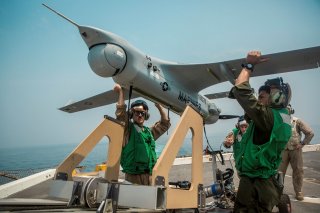Annoying or Real Threat? Here's What We Know About Iran's Navy
They appear to be a rag-tag joke.
Last month the U.S. Navy released videos of Iranian speedboats that had harassed U.S. warships in the Persian Gulf. USNI News reported that 11 of the fast-moving type of watercraft from the Islamic Revolutionary Guard Corps Navy (IRGCN) swarmed a group of American vessels, which were in international waters.
The nearly dozen Iranian vessels “repeatedly conducted dangerous and harassing approaches of the USS Lewis B. Puller (ESB-3), USS Paul Hamilton (DDG-60), USS Firebolt (PC-10), USS Sirocco (PC-6), USCGC Wrangell (WPB-1332) and USCGC Maui (WPB-1304) while the U.S. vessels were conducting joint integration operations with U.S. Army AH-64E Apache attack helicopters in the international waters of the North Arabian Gulf,” read a Navy statement on the matter.
At one point the Iranian vessels came within 10 yards of the U.S. Coast Guard’s Island-class cutter Maui and within 50 yards of the expeditionary mobile base Lewis B. Puller, and crossed the bows and sterns of the American vessels at high speeds. The U.S. Navy has said that the dangerous passes increased the risk of miscalculation and collision.
The U.S. crews issued multiple warnings via bridge-to-bridge radio, five short blasts from the ships’ horns and long-range acoustic noise maker devices. However, there was no response from the IRGCN.
“The IRGCN’s dangerous and provocative actions increased the risk of miscalculation and collision, were not in accordance with the internationally recognized Convention on the International Regulations for Preventing Collisions at Sea (COLREGS) ‘rules of the road’ or internationally recognized maritime customs, and were not in accordance with the obligation under international law to act with due regard for the safety of other vessels in the area,” added the Navy statement.
The provocations occurred two weeks after the Harry S. Truman Carrier Strike Group (CSG) departed from the Middle East, while only the Eisenhower CSG remains in the region. This has resulted in a rare occurrence where the U.S. Navy hasn’t had multiple strike groups, which hasn’t occurred in the region in years.
Perhaps the Iranians felt it was time to engage in some high seas saber-rattling, but the end result was less a display or actual threat of military force than something from an Iranian-version of MTV’s The Jersey Shore.
Moreover, it is even debatable whether the Iranians would appreciate being described as David to America’s Goliath, given that the story comes from the Hebrew Bible, despite the fact that David is venerated in Islam as a prophet and messenger. Yet even if so, Iranian speed boats don’t have anything resembling a sling powerful enough to take down multiple Goliaths.
Instead, this is a case where the Iranians could suggest that such actions drove way the Harry S. Truman CSG, and previously Iranian state media has declared that the IRGCN had successfully challenged the USS Abraham Lincoln CSG when the warships passed through the highly strategic Strait of Hormuz.
The small attack boats can present a real danger to merchant vessels in the region, and earlier in April IRGCN boats briefly seized a Hong Kong-flagged tanker SC Taipei in the Gulf of Oman. While the tanker and its crew was released after less than a day, such actions could be seen to border on piracy in international waters. Last year the IRGCN also detained a Swedish-owned tank for multiple weeks after the Royal Navy detained an Iranian tanker off its territory in Gibraltar.
Thus the greatest threat is not what the speed boats could do to American warships, but rather how a miscalculated action could create ripples far beyond the waters of the Persian Gulf. For now “The Persian Shore” speed boats are little more than a propaganda tool, but the danger is that the wrong move could quickly escalate from harassing action to an actual exchange of gunfire. It would be terrible if that happened in a region that doesn’t need any excuses for more conflict.
Peter Suciu is a Michigan-based writer who has contributed to more than four dozen magazines, newspapers and websites. He is the author of several books on military headgear including A Gallery of Military Headdress, which is available on Amazon.com.
Image: Reuters

